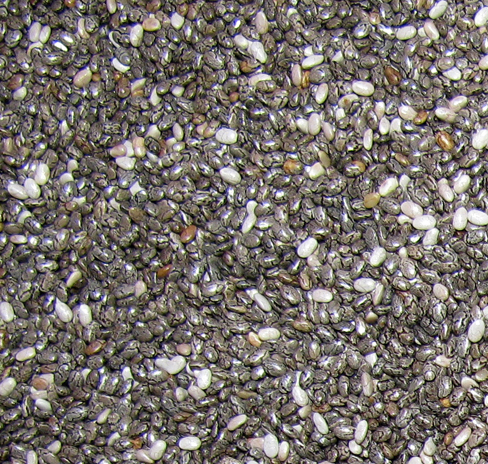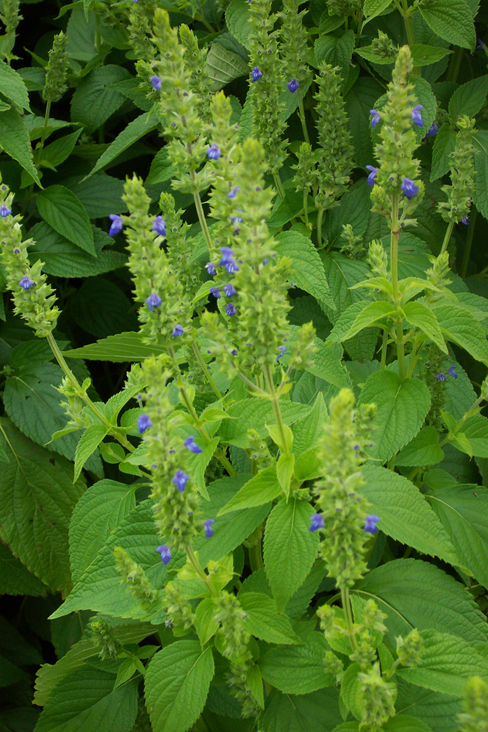Chia
Chia (Salvia hispanica) is an annual plant in the mint family that is grown commercially for its seeds, which are rich in omega-3 fatty acids. Chia seeds also provide an excellent source of soluble fiber and antioxidants. Until recently, chia seed production was only feasible in tropical and subtropical latitudes due to the long growing season required to complete seed development. While chia plants grow well in temperate climates, they require short days to flower and are normally killed by frost before seeds mature. Researchers at the University of Kentucky (UK) have been engaged in groundbreaking chia breeding research. This has resulted in patented varieties of long day length flowering lines of chia capable of producing seed in the Commonwealth and the Midwest.
Marketing
 UK’s new early summer lines of chia have been licensed to Heartland Chia, a producer-owned company in Franklin, Kentucky. Heartland Chia’s goal is “to provide a new crop opportunity for U.S. farmers while benefiting consumers, food and feed companies with a reliable, local, traceable supply of chia.”1 Heartland Chia provides growers with non-GMO seed and production advice to grow chia, then markets the chia they produce.
UK’s new early summer lines of chia have been licensed to Heartland Chia, a producer-owned company in Franklin, Kentucky. Heartland Chia’s goal is “to provide a new crop opportunity for U.S. farmers while benefiting consumers, food and feed companies with a reliable, local, traceable supply of chia.”1 Heartland Chia provides growers with non-GMO seed and production advice to grow chia, then markets the chia they produce.
Production
 Chia is an herbaceous plant with opposite, serrated leaves approximately 1½ to 3 inches long and 1 to 2 inches wide. Also known as “lime-leaf sage,” plants reach a height of a little more than 3 feet at maturity. High planting density can result in 5- to 6-foot-tall plants. Height also depends on planting date and day length. Clusters of blue to purple to white flowers develop on spikes forming at the end of each branch. Seeds are oval and approximately 2 mm (0.08 inches) long and 1 mm (0.04 inches) wide (similar in size to red clover or alfalfa seed). The shiny seed coat varies in color from cream to charcoal gray with darker irregular markings or specks. Chia is a low-maintenance crop that prefers moderately fertile, well-drained soils. While moisture is necessary for seedling establishment, this crop is highly intolerant of wet soils. Seeds are planted into a fully tilled seed bed using a standard grain drill or planter with small seed metering capability; some adjustments to this equipment may be necessary. Because of the small seed size, precision planting is important to ensure good seed-to-soil contact. Chia is planted in May or June and harvested in October in Kentucky.
Chia is an herbaceous plant with opposite, serrated leaves approximately 1½ to 3 inches long and 1 to 2 inches wide. Also known as “lime-leaf sage,” plants reach a height of a little more than 3 feet at maturity. High planting density can result in 5- to 6-foot-tall plants. Height also depends on planting date and day length. Clusters of blue to purple to white flowers develop on spikes forming at the end of each branch. Seeds are oval and approximately 2 mm (0.08 inches) long and 1 mm (0.04 inches) wide (similar in size to red clover or alfalfa seed). The shiny seed coat varies in color from cream to charcoal gray with darker irregular markings or specks. Chia is a low-maintenance crop that prefers moderately fertile, well-drained soils. While moisture is necessary for seedling establishment, this crop is highly intolerant of wet soils. Seeds are planted into a fully tilled seed bed using a standard grain drill or planter with small seed metering capability; some adjustments to this equipment may be necessary. Because of the small seed size, precision planting is important to ensure good seed-to-soil contact. Chia is planted in May or June and harvested in October in Kentucky.

